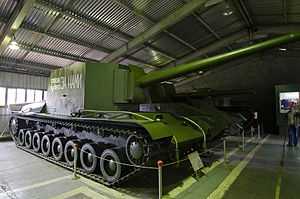SU-100Y Self-Propelled Gun
| SU-100Y | |
|---|---|
 | |
| Place of origin |
|
| Service history | |
| Used by | Soviet Union |
| Wars | World War II |
| Production history | |
| Designed | 1940 |
| Number built | 1 |
| Specifications | |
| Weight | 60 tonnes |
|
| |
Main armament | 130 mm Naval Gun B-13 |
Secondary armament | 3x 7.62 mm DT MG |
| Engine |
GAM-34BT 850 hp (630 kW) |
The SU-100Y was a Soviet prototype self-propelled gun, developed from the prototype T-100 tank. It was developed during the Winter War with Finland to include a 152 mm gun to destroy concrete defensive structures like bunkers and anti-tank obstacles. It did not see service before the end of the war but was brought into use in the Second World War in defence of Moscow.
History
In December 1939, the Northwest Command of the Red Army requested that the N°185 factory develop a vehicle based on the T-100. The vehicle had not only to operate as a self-propelled gun, but also to be used to lay bridges, transport explosives, and recover tanks destroyed or damaged on the battlefield. During the development of this vehicle, the ABTU proposed to mount the large, high velocity 152 mm cannon on the T-100 in order to give it the capacity to destroy bunkers and other strong fixed fortifications. The plant manager at N°185 proposed to stop the development of the prototype to use T-100 as a self-propelled gun armed with the 100 and 130 mm naval guns. This idea was accepted and on January 8, 1940, the plans of the T-100-X were finalized and sent to the Izhorskyi factory. The T-100-X had a box-shaped fighting compartment and was equipped with the 130 mm B-13 naval gun. For mobility, kept the torsion bar suspension system, as was the trend in modern tanks of the day. During the development of the prototype the shape of the fighting compartment was modified to reduce ammunition loading times. The new design was the SU-100Y (sometimes called T-100 there). The designs of the SU-100Y were sent to the Izhorskyi factory on February 24, 1940 and assembly began on the first of the month. The self-propelled gun was tested for the first time on March 14. As the Winter War was finished, the SU-100Y never saw combat.
During the Winter War it was proposed to modernize the T-100 with a more powerful armament, the 152 mm M-10 gun, able to destroy concrete structures, particularly in dragon's teeth, a common anti-tank measure amongst Europe's fixed fortifications during World War II. A new turret to accommodate the 152 mm howitzer was implemented around March 1940. This new model was designated T-100-Z. However this project was abandoned because of KV-1 and the 152mm equipped KV-2 tanks were superior. In April 1940, the N°185 factory proposed a self-propelled gun (prototype 103) for coastal defence based on the T-100 and armed with the B-13 130 mm naval gun installed in a rotating turret with three 7.62 mm machine-guns. This project never went beyond the drawing boards.
When work was stopped on the T-100 project, the SU-100Y was transported to Kubinka in the summer of 1940. In November 1941, at the most critical moment of battle in the suburbs of Moscow, the SU-100Y, together with the 152 mm gun armed experimental SU-14 and Su-14-1, was pressed into service in an Independent Artillery Division for Special Duties. Further information of the combat record of the unit has not been made known. Unlike its base model (T-100), the SU-100Y prototype survived the war and is a part of the collection at the Kubinka Tank Museum.
External links
| ||||||||||||||||||||||||||||||||||||||||||||||||||||||||||||||||||||||||||||||||||||||||||||